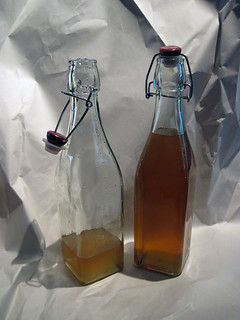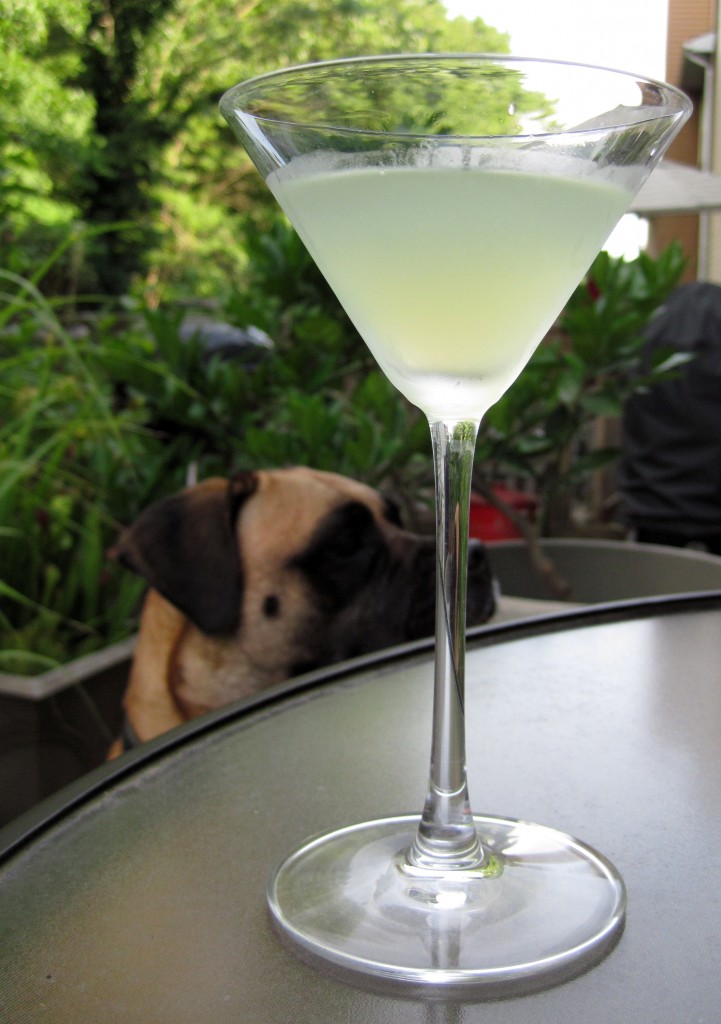You’ve got to love marketing text that takes stabs at young earth creationists. From Master of Malt.
Marketing Text: Read More
You’ve got to love marketing text that takes stabs at young earth creationists. From Master of Malt.
Marketing Text: Read More


This project predates my stated inspiration of the Adventures in Booze series, but only by a few days and was informed by my reading. We visited Onegin in NYC in June (warning: Flash heavy restaurant website. *sigh*) at recommendation of our hotel. The food was fantastic. We also decided to start out dinner with some of the house infused vodkas. I had the pear ginger vodka which was just fantastic.
I figured that it was probably something I could do myself at home. The internet agreed with me so I decided to give it a go. You can see my starting point in the first picture above. Basically I took 2 Asian pears, cored and sliced, and a couple of inches of ginger, peeled and sliced, and layered them in a jar. I left the skins on the pears since I figured, like apples, that’s where the most flavor is. Then I topped it all with a mid-range vodka and stuck it in the cupboard. A lot of the recipes I found online also called for adding a crapton of sugar. I left it out because I’m trying to cut down on extra sugar (she says, embarking on an alcohol-based drinking project) and I thought it might make it more versatile without the extra sugar. Also, Jason and I have different sweet levels we like and I wanted something both of us would enjoy.
I let it steep for about a week, maybe 10 days. I stirred it every couple of days to move the browning fruit around and to check the taste. At first the ginger was first and foremost. A bit of a ginger smack to the face. But then it settled down and the pear made itself known.
In the finished product, there’s a nice level of both flavors. Since I didn’t add any sugar, the sweetness is all from the fruit and is nicely light. I find it sweet enough to enjoy by itself over ice and Jason doesn’t find it overly sweet at all. “Pleasantly fruity” he says. I find both flavors to be subtle and I don’t think I’d want to mix it with anything because the tastes that you spend so long coaxing out would get lost.
I think the next time I make this I’m going to try it with different pears. Especially if I can find some really ripe ones, perhaps from a local orchard. I’m not actually sure if we have any around here. Lots of apples and peaches, but no idea on pears. Anyway, I think something riper and more flavorful would be better than the Asian pears I picked up. But it may also have to wait until I have jar space again…
This is a very interesting liqueur. I’ve been eyeballing it for a couple of years, but the $30+ price tag in Virginia ABC stores was daunting for something I had never tried before. Thankfully for my tastebuds, this project has caused me to throw fiscal caution to the wind.
From the ROOT about page:
Here at Art in the Age, we thought it would be interesting and fun to turn back the clock and recreate a true pre-temperance alcoholic Root Tea. We’ve even made it certified organic, since back then, everything was organic. […] It is NOT Root Beer flavored vodka or a sickly sweet liqueur.
And I have to agree. This stuff smells like a good old fashioned rootbeer. Think IBC. However, the taste is quite surprising. It’s not sweet at all and boy does the high alcohol content do a number on the tongue when sipped neat. I’ve tried it on the rocks and that was okay. I think because I was expecting the sweet fizz of soda from the smell, I found the flat dry taste to be really confusing.
Next I tried making a float out of it by adding club soda and a scoop of ice cream. This was a lot closer what I think I wanted because of the sweet from the ice cream. But it was still a bit not quite. I think this is why AITA recommends making floats by mixing ROOT with a rootbeer. However, I perused their recipe collection further and found the perfect cocktail.
Adapted slightly from ROOT’s Grass Roots recipe
1 part ROOT
1 part lime juice
1 part maple syrup (the real stuff. None of this pancake syrup crap.)
1 part Kraken RumCombine all ingredients in a cocktail shaker. Add ice and shake. Strain into a chilled martini glass.
This does not mix up as a pretty drink, as you can see from the image. Perhaps it was the fact that I’m using bottle lime which is a bit hazy anyway, but that plus the two dark brown liquors makes for something that looks a bit like an unfiltered fresh cider.
This is the best new drink I’ve shook up yet. It’s a wonderful balance of acid and sweet and all of the complicated flavors of the ROOT liqueur. For me, the wintergreen flavor becomes especially prominent which is awesome because I love wintergreen. I am planning on playing with creating a julep type of drink using ROOT and muddled wintergreen from my garden, but more on that another night. The only downside is that it’s easy to drink fast, which isn’t good considering the alcohol content. Be sure to pour responsibly, my friends.

Greta hangs out with us boozehounds on the deck.
½ ounce gin (Plymouth or another London dry gin)
½ ounce Verveine du Velay
½ ounce Luxardo maraschino liqueur
½ ounce fresh-squeezed lemon juice
1 sprig fresh lemon verbenaShake all the ingredients except the lemon verbena sprig with ice and strain into a cocktail glass. Rub a lemon verbena leaf around the rim of the glass and garnish with another leaf. If you can’t find Verveine du Velay, green Chartreuse is a fine substitute.
Second (and third) bottle of new-to-me booze is in this cocktail and boy do we have winners. I subbed in green Chartreuse because I could find that at the ABC store (Oh Virginia, I hate your liquor laws so much) which I guess brings it back to the more classic version of this drink. They did, however, have the maraschino liqueur. \o/ I am going to have to make maraschino cherries if I can still find cherries at Whole Foods.
Again, I used Bulldog gin because it’s what I’ve got. It’s a London dry so it fits the recipe. I skipped the lemon verbena bit because lazy and didn’t have any. I should add that to the plant list one of these days.
I was trepidatious about the Chartreuse after the Campari. In my reading, it would show up in the same sentence as Campari as an herbal liqueur. And we know how much I liked the Campari. However, this stuff was good! It’s herbal in a completely different way that reminds me more of the herbal shampoo I’ve been using for the last decade that I’ve sadly recently developed an allergy to. *whinge whinge whinge* Anyway. On it’s own, I find green Chartreuse to be sweet and have a delicious anise/licorice taste, especially on the finish. It’s not overpoweringly licorice, but just enough to be noticeable. It actually reminds me a lot of NECCCO wafers, to tell the truth.
The drink overall had this amazing floral character. It was the mix of sweet and acidic that I love with this aftertaste of a bouquet in your mouth. I went and tasted the Luxardo maraschino liqueur by itself afterwards and that’s where the taste comes from. Jason says it tastes like drinking perfume and I agree with that. A lot of times when you go to wine tastings, the pourer will talk about how the wine has floral nose but I have never found a wine that was like getting smacked in the palate with flowers like this liqueur. Not a bad thing though! It’s a bit overwhelming on it’s own, but in this cocktail? Marvelous.
Overall rating: fabulous summer cocktail. Will drink regularly.